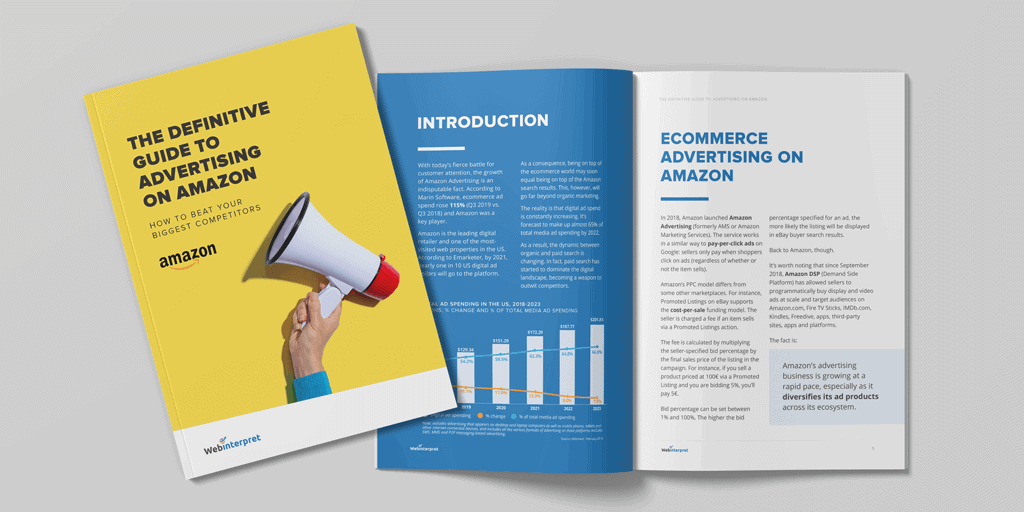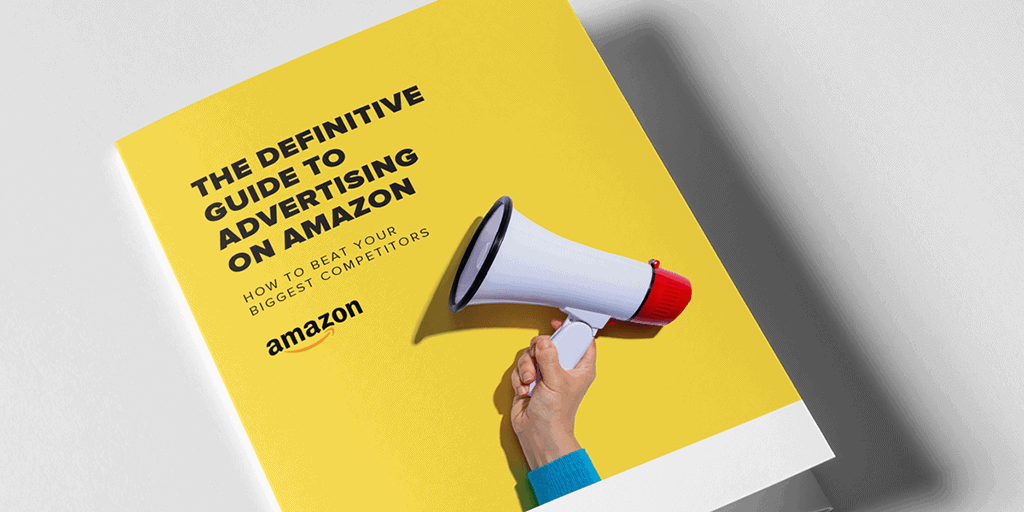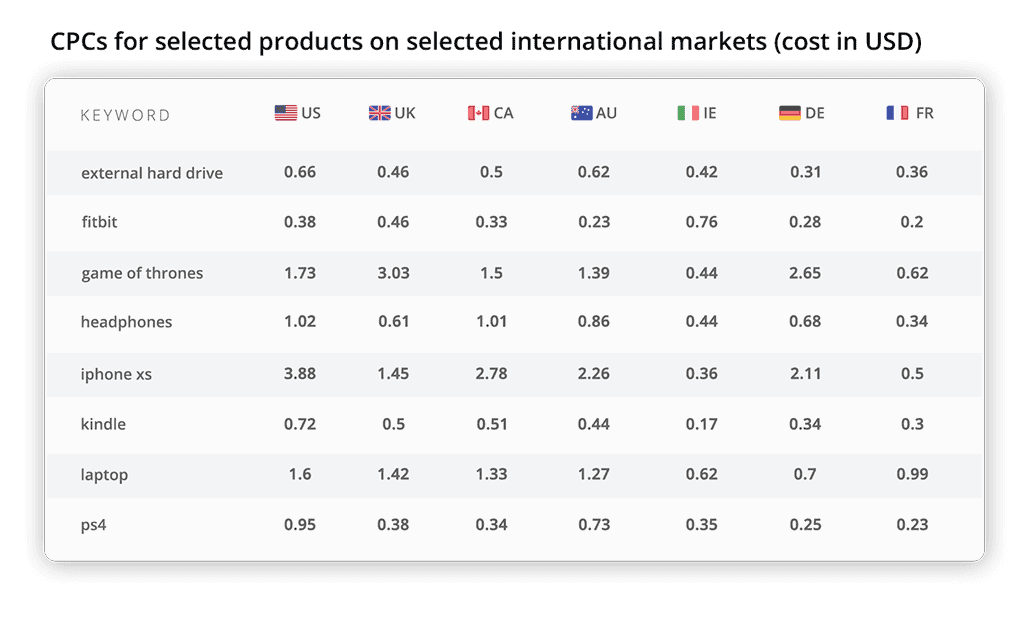Amazon Advertising: all you need to know [FREE guide]
This ecommerce guide will provide you with solid knowledge about Amazon Advertising. The following recommendations for your advertising strategy will help you beat your competitors and sell products online more successfully.
Amazon is the leading digital retailer and one of the most-visited web properties in the US. According to Statista, its global ad revenue reached 38 billion US dollars in 2022, which nearly doubled 2020’s results.
Amazon Advertising’s rapid growth reflects its status as a top player in retail media advertising, and goes hand in hand with high competition among sellers.
Here’s all you need to know about Amazon Advertising.
Amazon Advertising: FREE download
Ecommerce advertising on Amazon
In 2018, Amazon launched Amazon Advertising (formerly AMS or Amazon Marketing Services). The service works in a similar way to pay-per-click ads on Google: sellers only pay when shoppers click on ads (regardless of whether or not the item sells).
Amazon’s PPC model differs from some other marketplaces. For instance, Promoted Listings on eBay supports the cost-per-sale funding model. The seller is charged a fee if an item sells via a Promoted Listings action.
It’s worth noting that since September 2018, Amazon DSP (Demand Side Platform) has allowed sellers to programmatically buy display and video ads at scale and target audiences on Amazon.com, Fire TV Sticks, IMDb.com, Kindles, Freedive, apps, third-party sites, apps and platforms.
Amazon’s advertising business is growing at a rapid pace, especially as it diversifies its ad products across its ecosystem.
As to the actual data, US advertisers are estimated to spend $10.92 billion on Amazon’s platform in 2020.
Amazon is now the third-largest digital advertising platform in the US after Google and Facebook. According to eMarketer, Amazon accounted for almost 9% of US digital spend in 2019 (increase from 6.8% in 2018).
The largest digital ad seller in the world in 2019 is still Google (31.1% of worldwide ad spending, $103.73 billion), followed by Facebook ($67.37 billion in net ad revenues), Alibaba ($29.20 billion) and Amazon ($14.03 billion).
Amazon vs. Google vs. Facebook
Currently Amazon owns significantly less market share than Google and Facebook. However, Amazon’s advertising revenue skyrocketed by 250% in Q3 2018 compared to Q3 2017.
As a consequence, in the near future the long-standing advertising duopoly of Google and Facebook may turn into a triopoly with Amazon.
In 2018 Amazon was one of the biggest players in Google’s search and shopping channels. The company saw impression share climb in several retail verticals.
Advertisers see Amazon as a source of growth. This is the place where shoppers go to actually buy stuff as opposed to simply discovering or researching a product, like on Facebook and Google. Thus, Amazon’s goal is not to present information search results, but to make sales by showing high-converting and best-selling products relevant to the query.
According to Allie Decker, a content creator at HubSpot:
Today’s consumers don’t just use Amazon to buy stuff. They also use it to check prices (90% of consumers use Amazon to price check a product), discover new products (72% of consumers visit Amazon for product ideas), and start product searches (56% of consumers visit Amazon before any other site).
Amazon’s ad business growth: ecommerce research & data
According to Marin Software’s Q3 2019 Digital Advertising Benchmark Report, ecommerce ad spend rose 115% in Q3 2019 vs. Q3 2018 and was up 51% vs. Q2 2019. It was driven largely by Amazon, a seasonal surge for Prime Day and a strong back-to-school season.
Due to increased market saturation, the cost per ecommerce click was up 10.5% in Q3 2019 vs. Q2 2019.
Sponsored Brands accounted for about 20% of the ecommerce ad budgets in Q3. Due to the prominent top-of-page ad placement, the CPC for Sponsored Brands is slightly higher (27%) than that for Sponsored Products.
In short, Marin Software’s Q3 2019 Report highlights:
- Growing investment in ecommerce advertising
- New quarterly high in Q3 ad spend
- Record-breaking Prime Day
- Strong back-to-school season
- Prominent role of mobile.
According to Wes MacLaggan, SVP of Marketing for Marin,
Amazon continues to impact and shape advertising trends. Every brand of retailer has to have an Amazon strategy. It’s obviously a great channel and where people go when they’re searching for a product. There’s a cost for retailers of not being on Amazon.
Other reliable sources and reports confirm Amazon’s prominence in the ecommerce advertising playing field. According to “The Rise of Amazon Advertising” research report from Business Insider Intelligence:
- Amazon’s ad revenue growth is accelerating year-over-year (YoY). In 2018 Amazon generated $10.1 billion in ad revenue, up 117% YoY from $4.7 billion.
- Amazon’s ad business will grow overall as it diversifies ad offerings beyond display ads and across its variety of popular platforms (Amazon.com, Twitch, mobile app, IMDb’s Freedive) and devices (Fire TV, Echo).
- Amazon could tap into the $70 billion TV ad market as it ramps up ad-supported streaming video offerings, e.g. across its Fire TV devices, which could enable Amazon to attract bigger brands to premium content.
- By 2023, Amazon could take as much as 14% of total US digital ad sales, per Business Insider Intelligence estimates, based on eMarketer data.
- Amazon is likely to retain its dominant ecommerce position. It accounts for nearly half (47%) of total US ecommerce sales and 5% of the total US retail market (eMarketer).
Organic search vs. advertisements
Today, being first in organic may not mean that much on marketplaces. As Amazon and other platforms have increased the prominence of paid ads, the first organic result may pop up only in the middle of the page or even closer to the bottom!
It’s no longer enough to simply be on Amazon and occasionally post an ad. To outperform competition, sellers need to embrace and invest in new advertising products and opportunities.
To add to this, advertising has an impact on organic rankings. According to Patrick Smarzynski, Co-Founder at Webinterpret, there’s a definite relationship between ads and organic search.
For example, Amazon wants to prioritize the products that are likely to sell the most, i.e. products with good sales and feedback history. So when sales and the amount of feedback improve, products climb in organic rankings.
Advertising and Amazon search engine optimization can work together to increase sales. This means that when a product ranks better, depending on the competition, you can reallocate ad investments to other products and other keyword phrases.
Types of ads on Amazon
Amazon Sponsored Product Ads are the standard product listings that appear on the search results and product detail pages. They’re pay-per-click, keyword-targeted display ads for individual products. The link leads to the product details listing page.
Amazon Headline Search Ads (Sponsored Brand Campaigns) enable you to promote keyword-targeted ads of multiple products above, below, and alongside search results. They’re based on a pay-per-click, auction-based pricing model. You can direct the shopper specifically to your customized product page or your Amazon Store.
Amazon Product Display Ads are pay-per-click ads whose main objective is to cross-sell or upsell to your customers. This type of inventory, unlike the rest, is available to all advertisers, not just those selling on the platform. Amazon breaks down this category into display, video and custom.
Display ads appear on product detail pages, customer review pages, on top of the offer listing page and below search results. They can also be placed on abandoned cart emails, follow-up emails, and recommendations emails.
Amazon Video Ads can be placed on Amazon-owned sites like Amazon.com and IMDb, Amazon devices like Fire TV and various properties across the web. To buy Amazon video ads, you don’t have to sell products on Amazon.
Amazon Stores. Users can promote their product or brand on your own multi-page Amazon Store. Creating an Amazon Store is free. Brands get an Amazon URL and can view traffic analytics. You can showcase your brand’s products or portfolio of work.
Amazon Native Ads can be placed on your brand’s own website. These include recommendation ads, search ads and custom ads.
Advertising opportunities on Amazon
Ads help sellers to have satisfactory visibility and conversions. Advertising comes with many opportunities.
For starters, if you think of the shopper’s context when they see an ad, advertising on Amazon is already an advantage.
Imagine a shopper is being demographically targeted with ads whilst reading the Economist. The shopper isn’t necessarily in the “shopper mindset” so they may be less open to the ad. A better context would be when shoppers are visiting ecommerce sites, such as eBay or Amazon.
Ecommerce opportunities of using ads on Amazon include:
- The quality, brand-safe environment that advertisers want
- Reducing the sales cycle
- Improving sales history & product visibility
- Improving brand awareness
- Gaining valuable insights on changing consumer habits & optimizing campaigns to reach a more targeted audience
- Learning the best ways to acquire customers at a given time.
With advertising you can use tons of shopping journey data about who your shoppers are and how they shop, e.g. the actions shoppers took after seeing ads. Such data is key for designing successful ad campaigns and targeting at scale. Thus, on Amazon you can target based on real shopping and buying data, not just demographics and interests.
Marketplaces such as Amazon are leveraging shopper data to make digital experiences more targeted, personalized and intuitive. More shoppers, more purchases & more data require more advertising.
Further, being able to track your results is of paramount importance to make data-driven decisions. For example, you can track spend per click and how many sales result from clicks to understand what is earning you money and how to optimize Amazon Ads for (more) sales.
For example, if your Sponsored Products ad is sending traffic to your product page but there are hardly any conversions, you know you must improve that page, perhaps with better content, such as product description, additional product specs or product images.
Finally, and maybe most importantly, Amazon is one of the biggest marketplaces, so ad investment should pay off. The platform is very popular among online shoppers.
Some shoppers are so loyal to Amazon that they won’t even consider purchasing products off the platform!
Advertising challenges on Amazon & overcoming them
Amazon is one of the biggest marketplaces, but also a truly competitive one. Many brands name general competition with other brands as one of their main concerns. Further, the general ad load on the platform has increased and some search formats are saturated.
Thus, paid marketing campaigns can reach a plateau in a given market over time. Acquisition costs can significantly go up without adequate return on investment. This means little room for growth.
Further, Amazon is a fast-growing market where the rules of the game are changing fast. For example, the platform regularly adds capabilities and changes to how some products work. As a result, it can be challenging to be in the loop at all times.
To overcome any potential challenges, the starting point is creating an advertising plan in a conscious and data-driven way. Advertising your product to everyone & everywhere will be a waste of your time and money.
Instead, you must understand your goals, target audience and what you want to achieve with your strategy. Investment involves serious and strategic allocation of funds to ad products that will provide the best ROI.

Testing & optimization are an integral part of your Amazon advertising mix. Even if your current campaign is working well today, changes and updates are constantly happening on Amazon. Different trends are gaining traction all the time. Thus, change is the only constant.
However, the lack of continuity shouldn’t disrupt your day-to-day operations. Stay consistent, but also stay flexible.
Review your ads regularly, otherwise they may become irrelevant and ineffective over time. Try out different ad types, experiment with keywords, target demographics and content. Then allocate the rest of the budget where the sweet spot lies.
A good opportunity is to test new markets, especially those that have lower competition and can offer low CPCs (cost-per-click) & better return on advertising spend.
International sales opportunities on Amazon
When, over time, paid marketing campaigns reach a plateau in a given market, increasing CPCs further to grow traffic can decrease campaign clicks, sales and the overall profitability. What helps to increase profitability are lower CPCs on less competitive markets.
On Amazon you can sell on markets with less competition and more sales potential. These are often foreign markets where local online sellers aren’t able to offer specific products or meet the local demand. For example, in Italy many products have to be imported from abroad, e.g. clothes from foreign brands or vehicle parts for cars.
According to Herbert Knibiehly, Chief Marketing & Product Officer at Glopal, the possibility of satisfying the unmet demand for unique products from overseas is one of the biggest worldwide opportunities for ecommerce retailers.
On international markets, sellers can get the additional visibility to international buyers and the low CPCs on these markets. This can be a huge opportunity for Amazon sellers who want to stand out from their competitors.
Finally, Webinterpret’s ecommerce solution helps sellers leverage ads on different international markets. With access to comprehensive data and vast ecommerce knowledge, we can help merchants tap into their actual sales potential to achieve the best possible ROI.

Download the complete Amazon Advertising Guide & stay ahead of the competition!
Sources
- 6 optimization tips for Sponsored Brands
- The Ultimate Guide to Amazon Advertising
- Amazon Stores
- How Amazon Advertising is eating into the digital ad market
- Amazon Marketing Services
- eMarketer
- Why Brands Are Flocking To Amazon Advertising
- Marin Software: Digital Advertising Report
- Amazon Demotes Organic Results in Search
- Amazon Drives 115% Rise in Ecommerce Ad Spend
- 10 Marketplace Business Models To Generate Revenue
- Report: Product advertising is driving spend growth
- Amazon Advertising
- 7 Ways to Promote Your Amazon Listings
- The Future of Advertising on Amazon
- Statista
Related Posts:
Ecommerce Newsletter
By clicking the “Subscribe now” button, you agree to receive our monthly e-mail newsletter and regular marketing and commercial communications by email from Webinterpret regarding marketing trends and our digital marketing services. You confirm that you have read and agreed to Webinterpret’s Terms of Service and Privacy Policy.













![[Video] Turn clicks into sales with eBay Promoted Listings ebay-promoted-listings-expert-advice-video](https://www.webinterpret.com/wp-content/uploads/2023/11/ebay-promoted-listings-expert-advice-video-600x300.png)
